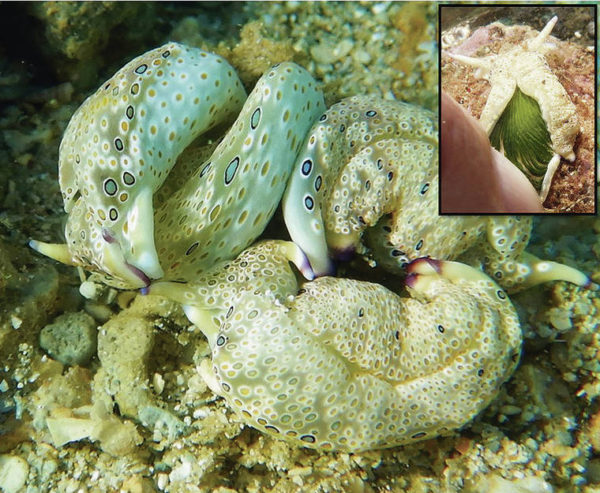Published in the Ocean Watch column, Honolulu Star-Advertiser © Susan Scott
June 29, 2019
Last week I found dozens of ringed sap-sucking slugs in one area of a shallow reef. These little charmers with the noncharming name look like nudibranchs (snails without shells, aka sea slugs), but the two groups have a major difference. Nudibranchs are carnivores, eating animals such as sponges, corals and sometimes each other. Sap suckers, as their name suggests, are vegetarians.
These remarkable creatures, however, do more with their food than simply suck it up. The ringed sap-sucking slug carries its provisions on its back in the form of a garden.
All snails have a tonguelike organ called a radula loaded with tiny teeth that the creatures move back and forth, like sandpaper, over a food source to scrape it off and swallow it.
 Four sap-sucking slugs. Inset: Susan Scott holds open a sap-sucking
Four sap-sucking slugs. Inset: Susan Scott holds open a sap-sucking
slug’s back flaps to show the creature’s stored chloroplasts.
©2019 Susan Scott
A sap sucker’s radula, though, has only a single row of needle-sharp teeth. After the leading tooth pierces a seaweed cell wall, its job is done, apparently dulled by its work.
Instead of dropping it, though, the snail, for reasons unknown, stores its used teeth in a little pouch inside its radula. And that’s the origin of the group’s name Sacoglossa, meaning sack tongue.
The next tooth in line advances to the front to take another stab.
After a tooth perforates a seaweed cell wall, the sap sucker empties the cell though a tube, sucking the contents, or sap, into the snail’s digestive system.
But the 2-inch-long ringed sap-sucking slug doesn’t simply digest the plant’s juices. The animal is able to confine some of the plant’s green chloroplasts undamaged and store them under covers on its back for its own use when food is scarce. The chloroplast garden continues making carbohydrates from photosynthesis and helps the creature keep its pantry stocked.
Because sunlight helps the creature survive longer with little fresh food, sap- sucking slugs are nicknamed solar-powered slugs.
Most sap-sucking slug species (Hawaii hosts at least two) eat a specific kind of seaweed, which restricts the creatures to limited ranges.
Like most nudibranchs, sap-sucking slugs are hermaphrodites, bearing both eggs and sperm. They sometime mate in groups, with one inserting its penis into a female genital pore, while that individual gets sperm deposited into its own genital pore and so on. Sometimes a sap sucker injects its sperm hypodermically into the flesh of another.
Several years ago I found dozens of individuals of this species in this area, but after North Shore winter surf, they were gone. I’m delighted to see them back, and to find bundles of the beauties busy making more of their kind.
Welcome back, little tooth fairy gardeners. You suck and I love you for it.